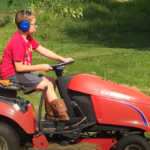






Educator Drew Perkins Gives His Daughters a Surprising — and Transformative — Homework Assignment
The Let Grow Project, a homework assignment where students choose something new to do on their own, doesn’t just change the kids.
After 15 years as a teacher, Drew Perkins is now TeachThought’s Director of Professional Development and co-host of the TeachThought Podcast. He has designed and contributed to several PBL (project-based learning) models and embraces his reputation as a “professional thought stretcher.”
Drew recently stretched himself AND his daughters Sadie (14) and Lilah (12) after reading my book, Free-Range Kids. We spoke, quaintly enough, by phone.
What moved you to “stretch” yourself and your kids?
When I read about The Let Grow Project in your book, I thought: That’s a helluva an idea. Why haven’t I thought of that?
You mean, why hadn’t you thought of asking your kids to do something new, on their own, as a learning experience? Because most families are busy with a million other things. What did your daughters end up doing?
We have free lunch in our schools and during the pandemic the card kept re-loading so there’s $636 on it and I thought: We can take the card, purchase the food, and deliver it to the food bank. I did it once by myself, and once with the girls, but the third time I thought this would be a good opportunity for them. So we had dinner and got snow cones, and when they said, “Hey, can we go look at a puppy?” I said, “Actually we’re going to go to Kroger. I want you to go in and fill up the cart for the food bank. Here’s a screen shot of all the stuff they want.”
A supermarket adventure!
There was a little bit of, “Wait – we’re going to go in there by ourselves?” And I was like, “Yeah. This isn’t hard. You can do it.”
So –?
I dropped them off and said, “When you come out, I’ll be here.”
What happened when they did, I presume, come out again?
They were excited to tell me what happened. The checkout person, who was apparently new, said something like, “Did mom send you shopping?” And they said, “We’re getting this for a food bank!” And she said, “God bless you,” and one person in line said they used to get food from that food bank.
Wow! What are the odds?
Then the checkout person started checking out the next person’s items as theirs, so there was a little bit of awkwardness, which is obviously good – that’s real life.
Yes, kids learning to interact with the world is fantastic! And how were you while you waited?
This was almost comical. I’m parked out in front of Kroger thinking, “All right. I can see both of the entrances and exits. I’ll just sit here…” and a police officer pulls up next to me and says, “I need you to move.” And I said, “I’ve sent my daughters in to do an Independence Project and get food for the homeless!” And he said, “Well, if you can, pull over to the parking lot.” I thought about some of the stories from your book – there have been instances where the police say, “You’ve done WHAT?” But he actually said, “You wouldn’t believe how many people call and complain about people parking in front of Kroger.”
So you had a little independence-building of your own. Would you say the experience changed your kids at all?
They were clearly excited. I think they felt a sense of pride and accomplishment. My youngest has some generalized anxiety, but how do you build self-efficacy? You give opportunities to try and fail and flail – a chance to experience the real world.
What’s next?
It may be too early to tell, but I think it’s an entree to doing it more. As a teacher you scaffold things and give students opportunities to grow from wherever they are. So the next step is that you can go in there, not two of you but ONE of you – and look at all these amazing things that you can do.
What would you suggest other parents do?
Read your book!
But of course! (Here’s a free download of the chapter for educators.) What else?
I would suggest they find ways to provide opportunities for their kids to grow outside the parental aura.
Do you think this shopping experience will have any impact on your kids as students?
I tell them, whether it’s in the classroom or other settings, you have to learn how to advocate for yourselves. You have to develop the skills of talking to the adult in the room to say, “I’m struggling with this,” or, “I think I can do this differently.” My oldest has repeatedly said, “I don’t like it when the teacher talks to me one on one. It’s really awkward.” Well – you went to the grocery and talked with adults. So hopefully now you can go into the classroom and talk to the teacher.
You, yourself talk to teachers a lot. Would you recommend they assign The Let Grow Project?
One of the things we talk about it in our work is: How do we help students autonomously manage the process in project-based learning? You want them as much as possible, and as soon as possible, to manage their learning. And when you give them opportunities to do that —
You mean, by letting them do something interesting to them in the real world —
Yes, it lets them practice, “Oh, that didn’t work. I’m going to do it differently next time.” There’s a thing we say: Whoever’s doing the work is doing the learning.
Your kids did the work — and learning — that night. But in a way, so did you. Thank you so much for sharing the experience, Drew!
This interview was edited for length and clarity.
To download The Let Grow Project, please click here. All our materials are free.



Comments are closed for this article.